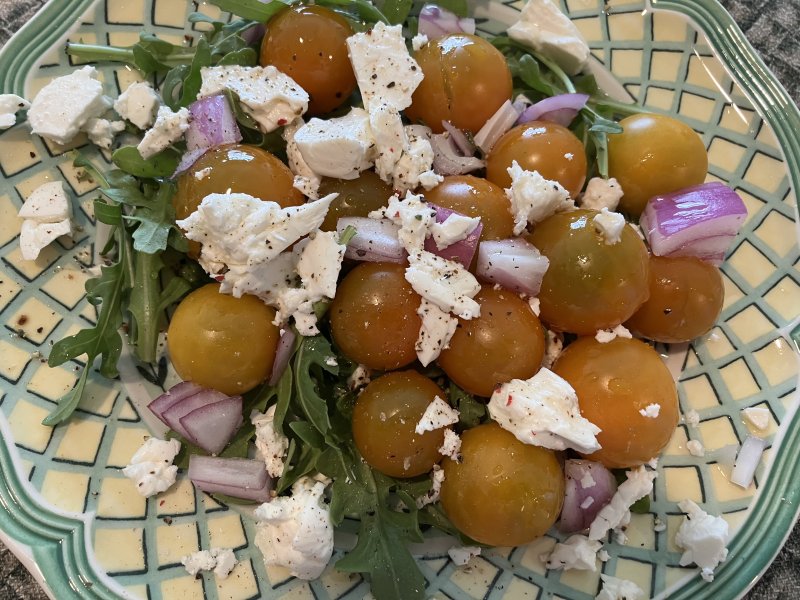Get your recipes ready; peak tomato season is coming soon
We’re just beginning to see tomatoes at the grocery stores — not the hothouse-raised, cellophane-packaged, tasteless specimens, but the early harvest from local farms. The largest selection won’t be until next month, when a wide range of tomato varieties will be available. In the meantime, I was able to enjoy the bounty from my neighbor Paula, who has a thriving vine on her sunny patio.
The orange-colored cherry tomatoes in the photo had already ripened before the end of June and have been growing in such abundance, Paula’s been gifting the little beauties. Cherry tomatoes are named for their resemblance to a cherry, round in shape and small in size. These are typically sweeter than full-size tomatoes and have a higher water content, as observed by anyone who has felt the squirt of juice when biting into one.
The other variety of small or bite-sized tomatoes is the grape tomato, which is oblong with a thicker skin. Grape tomatoes have a classic tomato taste and are meaty, with an almost crunchy texture to the skin. Both types are rich in vitamins A and C, as well as the powerful antioxidant lycopene. Lycopene is a carotenoid, a natural pigment that gives vegetables their red, orange and yellow colors.
Wild tomatoes originated in the Andes region of South America. The ancestors of our modern tomatoes were tiny (smaller than cherry tomatoes), tart and quite hardy. Cultivation and hybridization efforts of the Incan and Mayan civilizations gave us the early varieties that were similar to our cherry tomatoes, as well as the name we call the fruit, which comes form the Aztec word xitomatl.
As Europeans colonized the Americas, they returned home with novel foods such as chocolate, chili peppers, corn and tomatoes. Tomatoes were not given a warm welcome on the European continent because they were believed to be poisonous. This stemmed from the resemblance of their foliage to the Mediterranean mandrake plant, a known hallucinogen. Tomatoes are also members of the deadly nightshade family of plants.
Another contributing factor to their bad reputation was that many upper-class Europeans used pewter plates. When the acidic tomato juices leached lead from the metal plates, this effectively caused lead poisoning in the diners. During the colonization of North America in the 1700s, tomatoes were grown primarily as an ornamental plant. An early adopter of the tomato as food, Thomas Jefferson grew them in his Monticello garden.
While small, local farmers offer heirloom varieties that come in a vast spectrum of colors and sizes, the commercial production of tomatoes is handled differently. Instead of waiting to harvest when the tomatoes are ready to eat, industrial tomato producers collect them when they are unripe and still green in color. They are treated with ethylene, a plant hormone that hastens ripening, to turn them their familiar red color.
Today there are thousands of different varieties of tomatoes, and they are used in almost every cuisine throughout the globe. From Italian red sauce to Spanish gazpacho to brunch-time bloody Marys, tomatoes can be found on the menu wherever you look. I’ve included a recipe for the simple tomato feta salad in the photo, as well as my version of gazpacho, which omits the traditional bread thickener, as there are plenty of carbs in the sweet, ripe tomatoes.
Tomato Feta Salad
Arrange arugula on a serving plate. Rinse and dry the tomatoes; scatter over the arugula. Sprinkle with cheese and onion. In a small bowl, whisk together olive oil, lemon juice and vinegar. Season to taste with salt and pepper. Drizzle dressing over the salad and serve. Yield: 2 to 4 servings.
Gazpacho*
Peel cucumber; finely chop 2 inches of flesh and reserve for garnish. Roughly chop the remainder and place in the bowl of a blender or food processor. Trim and seed the bell pepper; add to the blender. Remove skin from onion; add to the blender. Peel the garlic; add to the blender. Roughly chop the tomatoes; add to the blender, along with any juices. Add remaining ingredients to the blender and process until smooth. Adjust seasoning to taste with salt and pepper. Chill for at least 2 hours. Serve garnished with reserved chopped cucumber. Yield: 4 servings. *Adapted from Love and Lemons.





















































